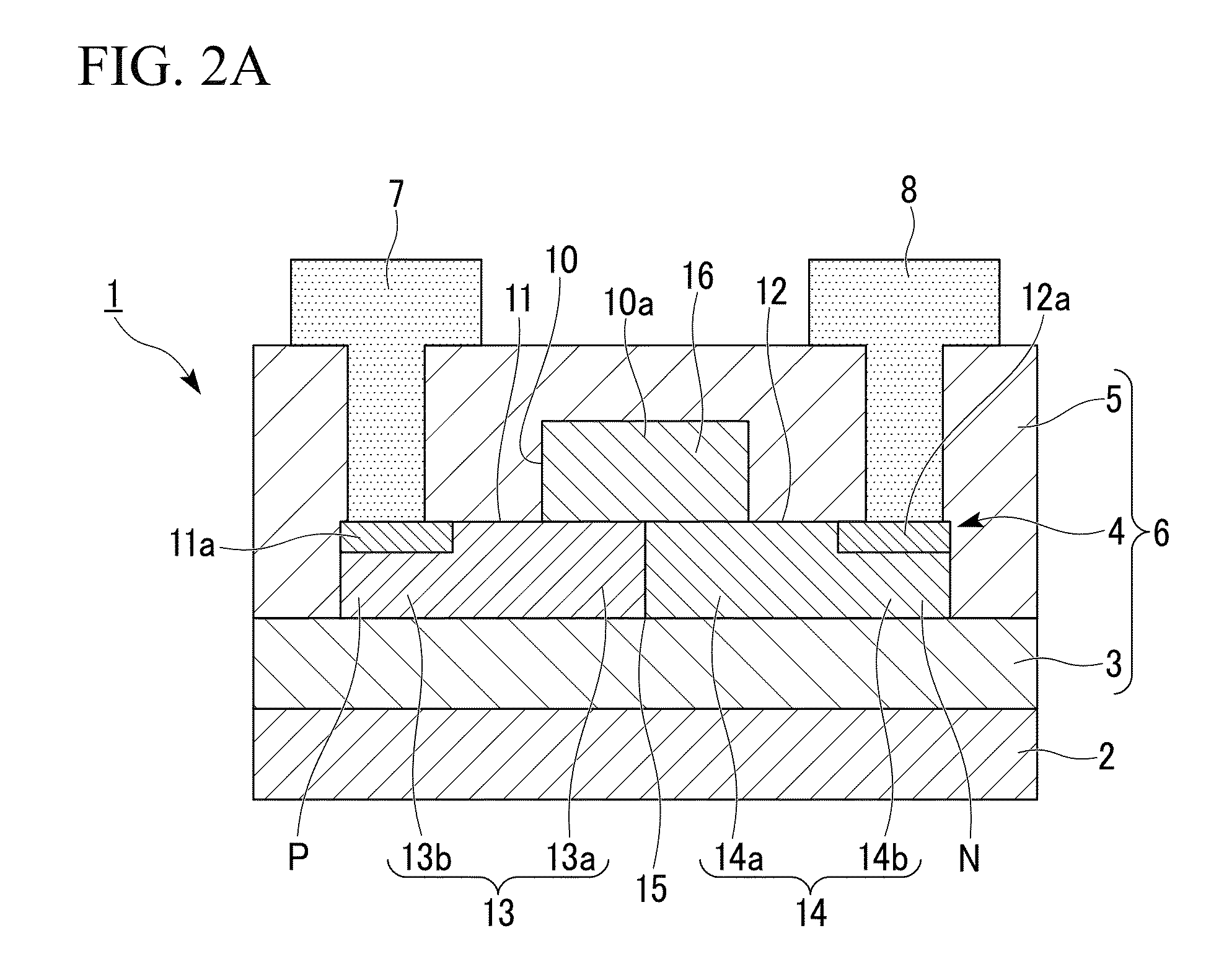Optical element and mach-zehnder optical waveguide element
a technology of optical waveguide and optical element, which is applied in the direction of optical waveguide light guide, optical light guide, instrument, etc., can solve the problems of light diffusion in the advancing direction of light, size, price, and increase of power consumption, so as to reduce the amount of loss change, increase the proportion of the region, and increase the width of the depletion layer.
- Summary
- Abstract
- Description
- Claims
- Application Information
AI Technical Summary
Benefits of technology
Problems solved by technology
Method used
Image
Examples
first embodiment
[0118]FIG. 1A is a cross-sectional view showing an optical element according to the first embodiment of the present invention. In addition, FIGS. 2A, 2B, and 3 show a configuration example in which electrodes are provided to the optical element.
[0119]FIG. 1A and FIG. 2A show a cross-sectional view showing a section perpendicular to the advancing direction of light (longitudinal direction of the optical waveguide). In the present embodiment, an SOI (Silicon On Insulator) substrate made of silicon (Si)-silica (SiO2)-silicon (Si) can be used as a substrate for use in manufacturing. A lower cladding 3 of the optical waveguide 6 is formed from SiO2 in the middle of the SOI substrate and the core 4 is formed from the upper Si layer. The lower Si layer forms a substrate 2.
[0120]The core 4 is a rib silicon waveguide and includes the rib part 10 which is thick at the center. Light transmitted into the waveguide will be distributed centering on the rib part 10.
[0121]On the other hand, the sla...
second embodiment
[0138]By calculating Δn / Δα based on the above-described Equation 1 and Equation 2 with neglecting the change in electron density ΔNe, it is found that Δn / Δα is approximately inversely proportional to the hole density ΔNh to the power of 0.2 [i.e., Δn / Δα∝1 / (ΔNh)0.2] in the P-type region. On the other hand, in the N-type region, with neglecting the change in hole density ΔNh, Δn / Δα stays approximately constant regardless of the electron density ΔNe.
[0139]These relationships are shown in a graph in FIG. 17. It is noted that the horizontal axis in FIG. 17 represents the carrier density, in which ΔNe is used for electrons and ΔNh is used for holes. In addition, the numbers in FIG. 17 are expressed in a manner that 1×10±m is 1E±m (±m is an integer).
[0140]As is clear from FIG. 17, since Δn / Δα is high in the P-type low-concentration region, it is possible to increase Δn / Δα and reduce the amount of the change in loss by increasing the proportion of the P-type low-concentration doping region ...
third embodiment
[0144]In the first and second embodiments, the high-concentration doping region for making contact with the metal electrodes 7 and 8 is formed in the upper part of the slab parts 11 and 12. Since absorption of light in the metal material used for the electrodes 7 and 8 is large, it is required to separate the electrodes 7 and 8 sufficiently from the region in which guided light will be distributed, in order to reduce the absorption. However, as separating the electrodes 7 and 8 from the region in which guided light will be distributed, the distance between the electrodes 7 and 8 and the PN junction part 15 becomes larger. This will increase the resistance value in the semiconductor between the electrodes 7 and 8 and the PN junction part 15 and cause reduction of the response speed of the semiconductor constituting the core, or the like, resulting in deterioration of the high frequency characteristic.
[0145]In view of the above, as shown in FIG. 6, it may be possible to arrange contac...
PUM
| Property | Measurement | Unit |
|---|---|---|
| refractive index | aaaaa | aaaaa |
| concentration | aaaaa | aaaaa |
| height | aaaaa | aaaaa |
Abstract
Description
Claims
Application Information
 Login to View More
Login to View More - R&D
- Intellectual Property
- Life Sciences
- Materials
- Tech Scout
- Unparalleled Data Quality
- Higher Quality Content
- 60% Fewer Hallucinations
Browse by: Latest US Patents, China's latest patents, Technical Efficacy Thesaurus, Application Domain, Technology Topic, Popular Technical Reports.
© 2025 PatSnap. All rights reserved.Legal|Privacy policy|Modern Slavery Act Transparency Statement|Sitemap|About US| Contact US: help@patsnap.com



